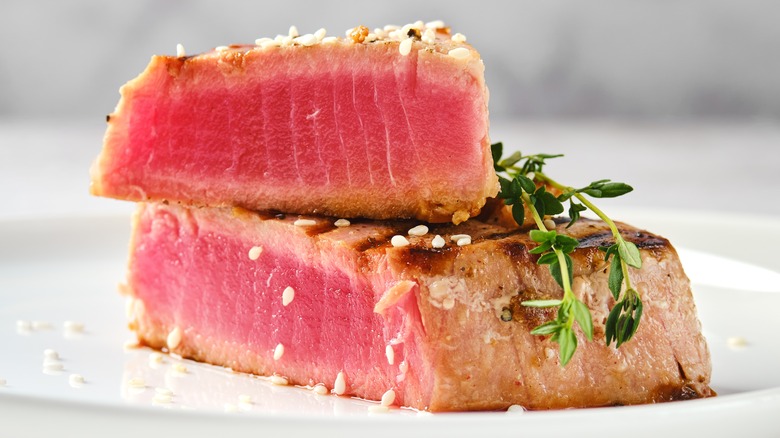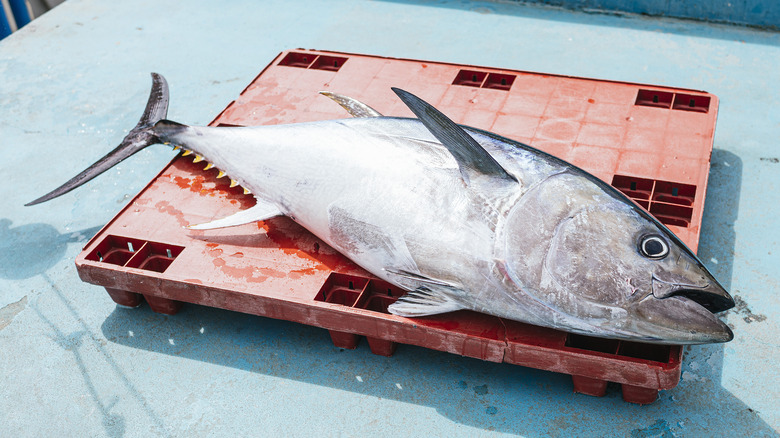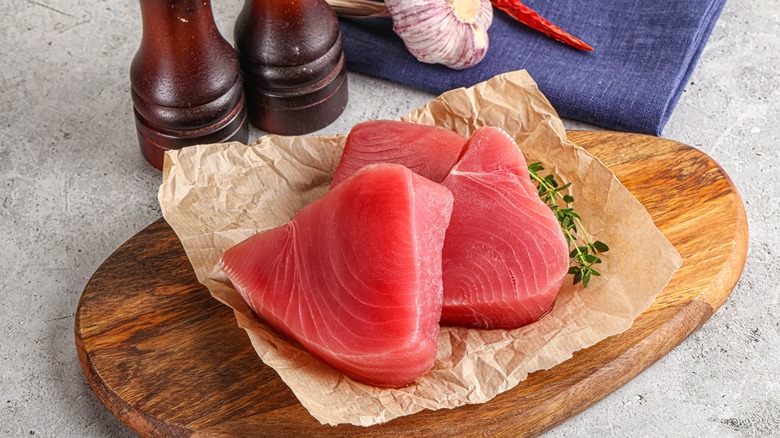Ahi Vs Albacore Tuna: What Makes Them Different?
Just as beef connoisseurs might be able to tell the difference between a wagyu and a holstein steak, there are different varieties of tuna that can also vary broadly in terms of taste, scope, and application. While there are many species of tuna roaming the oceans, the commercial fishing industry targets five main species for human consumption: albacore, bigeye, bluefin, skipjack, and yellowfin. Skipjack tuna has the lightest, flakiest meat, followed by albacore, yellowfin, bigeye, and bluefin. Bluefin is prized for being able to store fat in its musculature, resulting in a highly rich, flavorful cut.
Albacore is among the most popular tuna species — it's often sold canned in supermarkets and used for a variety of simple preparations. It's the only kind that can be labeled "white tuna," according to the National Oceanic and Atmospheric Administration (NOAA). The fishing industry uses the white meat designation to differentiate canned albacore tuna from "chunk light," which may contain skipjack or yellowfin. "Ahi tuna," on the other hand, is a Hawaiian name for yellowfin. This species tends to have a more meaty, steak-like texture that lends itself well to grilling, but can also be eaten raw.
Albacore and ahi differ in habitat, size, and harvesting
Both albacore and yellowfin tuna are harvested in the Atlantic and Pacific Oceans. While albacore tuna can grow to a decent size — over 4 feet long and 88 pounds in body mass — yellowfin can grow significantly larger, up to 7.8 feet in length and 440 pounds.
Both fish are harvested year-round, and in both cases, U.S. consumption represents just a minuscule proportion of overall harvesting: for example, U.S. fishermen are responsible for about 1% of all North Atlantic Albacore catches, according to NOAA. The federal agency estimates that the U.S. harvested about 490,000 pounds of albacore tuna in 2021, compared with about 1.4 million pounds of yellowfin tuna in 2022 (per NOAA).
U.S. harvests of yellowfin tuna also comprise a small amount of overall catches, and in 2022, Hawaii collected more yellowfin tuna than any other state, with about 6.6 million pounds. Nearly all of the roughly 5.6 million tons of tuna harvested for human consumption annually are wild-caught, but a small amount of bluefin tuna is farmed each year.
How to prepare ahi and albacore tuna
Because albacore often comes canned already, it can be readily incorporated into several go-to recipes, like a tuna salad sandwich, tuna melt, or casserole. In a tuna salad sandwich, the mild flavor of albacore can be enhanced with tahini or lemon juice, in addition to typical ingredients like capers and celery. Albacore filets can also be grilled and turned into a more extravagant grilled tuna sandwich, and enhanced with spicy ingredients including horseradish and ground red pepper.
Yellowfin tuna can regularly be purchased as fillets, and home chefs can approach their cooking much like they would a steak. Since it's purchased raw, ahi can be turned into tuna tartare by dicing them, and adding ingredients like garlic, ginger, soy sauce and sesame seeds.
A similar approach can be used to turn yellowfin filets into spicy tuna sushi bowls. By giving the filets a quick sear in a pan with a high smoke point oil such as sesame, and then seasoning with salt, pepper, and sesame seeds, you can create tender tuna steaks with a crunchy exterior. Yellowfin fillets can also be prepared with salt, pepper, and a mayo or aioli-based marinade before being grilled.



